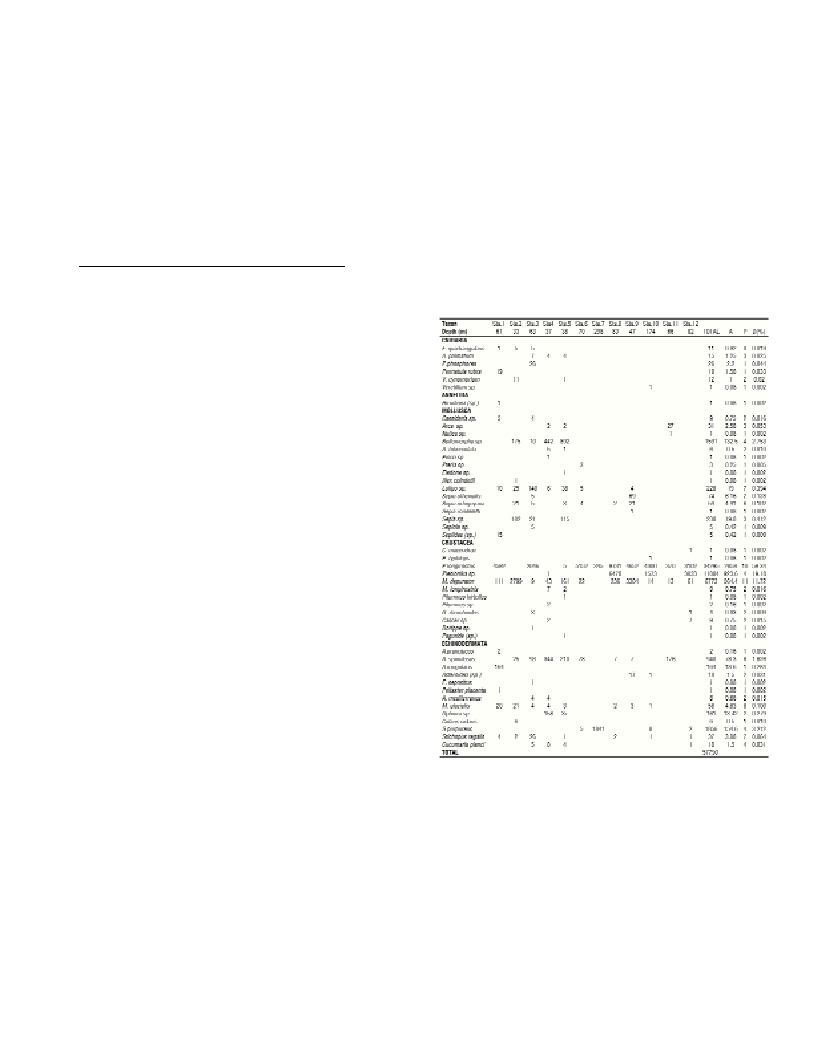THE MACROZOOBENTHIC INVERTEBRATE FAUNA IN THE MARMARA SEA
Bülent Topaloglu
*
, Bayram Öztürk, F. Saadet Karakulak
Istanbul University. Faculty of Fisheries, Laleli, Istanbul, Turkey
Turkish Marine Research Foundation, Beykoz, Istanbul, Turkey
topalbl@istanbul.edu.tr, ozturkb@istanbul.edu.tr, karakul@istanbul.edu.tr
Abstract
Macrobenthic invertebrate were collected from 12 stations in the Marmara Sea. A total of 48 taxons were identifed. The highest species
diversity was found in the southern Marmara with 19 taxons, whereas in the northern Marmara, only 2-9 taxons were identified.
Macropipus depuratorhas the highest presence with 11, and Parapenaeus longirostrishas highest dominance with 59.34 and highest
abundance with 2853 specimens. A high diversity of species was found between 30-63 m in the stations around the Marmara islands. In
the northern Marmara, 5-9 species were found between 66-174 m, and only two species at the 298 m station. As a result, the species
diversity was found to be higher in the Southern Marmara Sea especially around the Kapida
g
Peninsula.
Keywords: Marmara Sea, Benthic Ecology, Diversity
Rapp. Comm. int. Mer Médit., 37,2004
554
Introduction
The Marmara sea is an important biological corridor/barrier
between the two different marine ecosytems of the Black and
Mediterranean seas (1, 3). Therefore, biological diversity research is
important, for the development of conservation strategies within the
Marmara Sea. The Marmara Sea has a two layer current system with
different ecological conditions in the upper and deep layers, it has
three depressions in the east-west direction down to 1000 meters (2).
Few studies have been made on the ecology of the Marmara Sea (1, 4,
5). The present research studied the general composition of macro-
zoobenthic invertebrates, focusing on the difference between the
northern and southern parts of the Marmara Sea.
Material and Method
This study was carried out between 1 and 19 August 2001. Twelve
stations were sampled using a bottom trawl net with our research ves-
sel R/V Yunus. The samples were collected at depths between 33 m
and 298 m. Stations 6-8,10-12 were located in the northern Marmara
and stations 1-5 and 9 were located in the southern Marmara. Each
sample was described, measured, counted and weighed. An echo-
sounder was used to measure depth.
Calculations of abundance, presence and dominance were made.
Abundance (A) is the mean number of the individuals from the total
number of samples, presence (P) the number of observations of a
species from the total number of samples. A “P” value of 11 indicates
11 stations and dominance (D) is the propotion of the total number of
one species to the total number of all organisms.
Results and Discussion
A total of 48 taxons were determined including two classes, two
families and 15 genera. Abundance, presence and dominance were
calculated after the description. Macropipus depuratorhas the highest
presence (in 11 out of 12 stations), and Parapenaeus longirostristhe
most dominant with 59,34 and most abundant with 2853 specimens.
The highest diversity of species was found between 30-63 meters (sta-
tions 3 and 5, 19 species; 16 species at station 4, 13 species at station
1; and 12 species at station 2, around the Marmara islands). In the
northern Marmara between five and nine species were found in the 66-
174 meter range and only two species in the 298 m. range (Table 1.).
The Marmara Sea has a two layer current system with different
oceanographic conditions. The upper layer originated in the Black Sea
and has low salinity waters. The lower layer is originally from the
Mediterranean Sea and has a higher salinity and the southern part of
the Marmara Sea is shallower than northern part. The Marmara Sea
has three depressions down to 1000 m in an east-west direction. All
these oceanographic and morphometric conditions affect the distribu-
tion of macrozoobenthic invertebrate fauna. As a result, the species
diversity was found to be higher in the southern part of the Marmara
Sea, especially around the KapidagPeninsula.
Table 1. Species with number of individuals, values of abundance (A),
presence (P) and dominance(D) in sampling stations.
References
1-Öztürk B., 2002. The Marmara Sea, A Link Between The
Mediterranean and The Black Sea. Pp.337-340. In: E. Leppekoski et al
(eds), Invasive Aquatic Species of Europe. Kluwer Academic Publ.,
Netherlands.
2-Besiktepe S.T., Özsoy E. and Latif M.A., 2000, Marmara Denizi’nin
hidrografisi ve dolasimi. Pp.293-313. In:Öztürk B., Kadioglu M. and
Öztürk H., (eds), Marmara Denizi 2000 Sempozyumu Bildiriler Kitabi.
TÜDAV Publ. No: 5., Istanbul.
3-Öztürk B. and Öztürk A.A., 1996. On the biology of the Turkish Strait
system. Monaco No: special 17; CIESM Science Series.
4-Balkis H., 1995. Ecology of the Crabs Living in the Sea of Marmara.
Pp.1-23. I.Ü Fen Fak. Biyoloji Dergisi. 58, Istanbul.
5-Balkis H., 1992. Marmara Adasi littoralinin makrobentosu üzerine bir
ön arastirma. Pp.309-327. I.Ü. Deniz Bilimleri ve Cografya Enstitüsü
Bülteni. No: 9., Istanbul.

